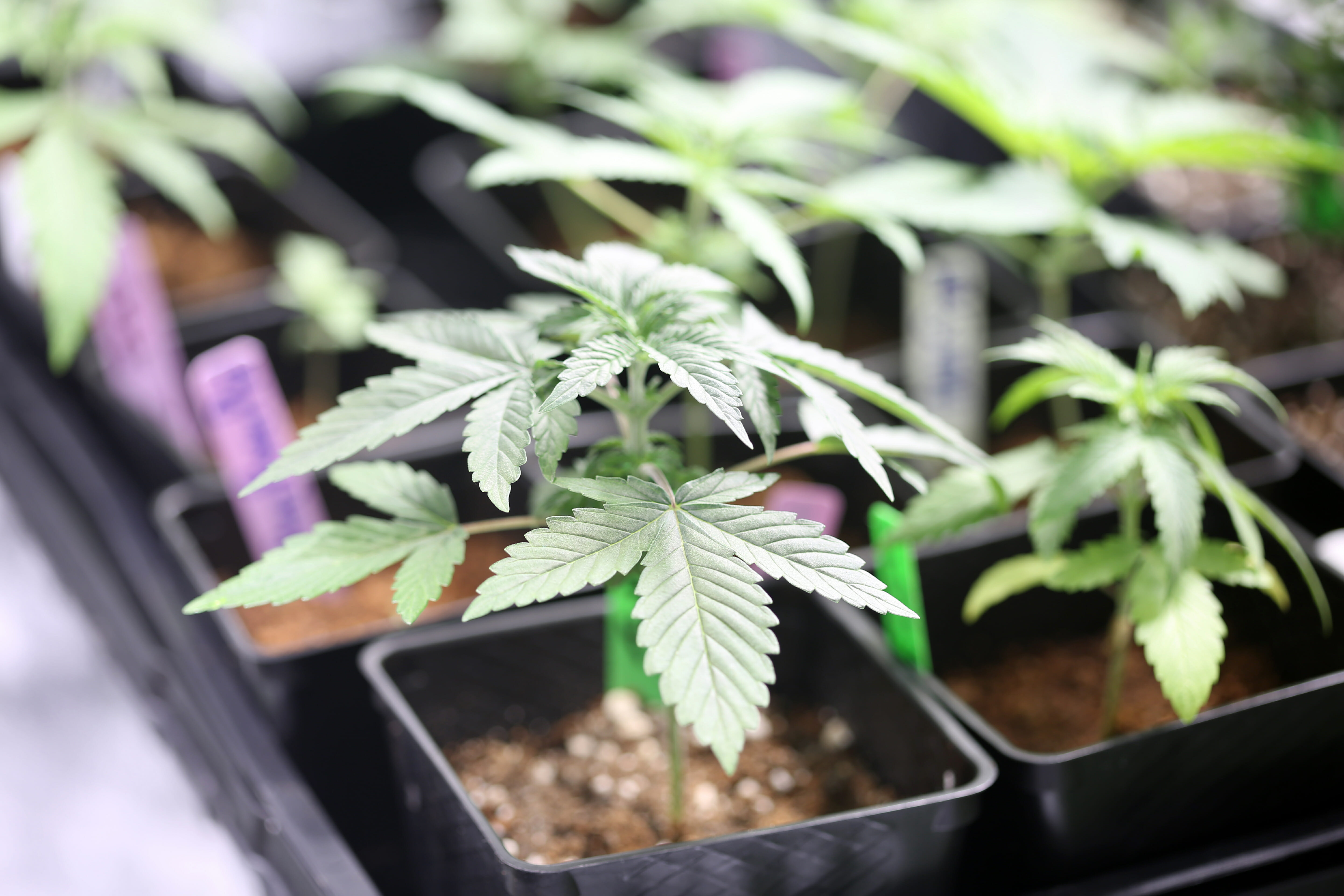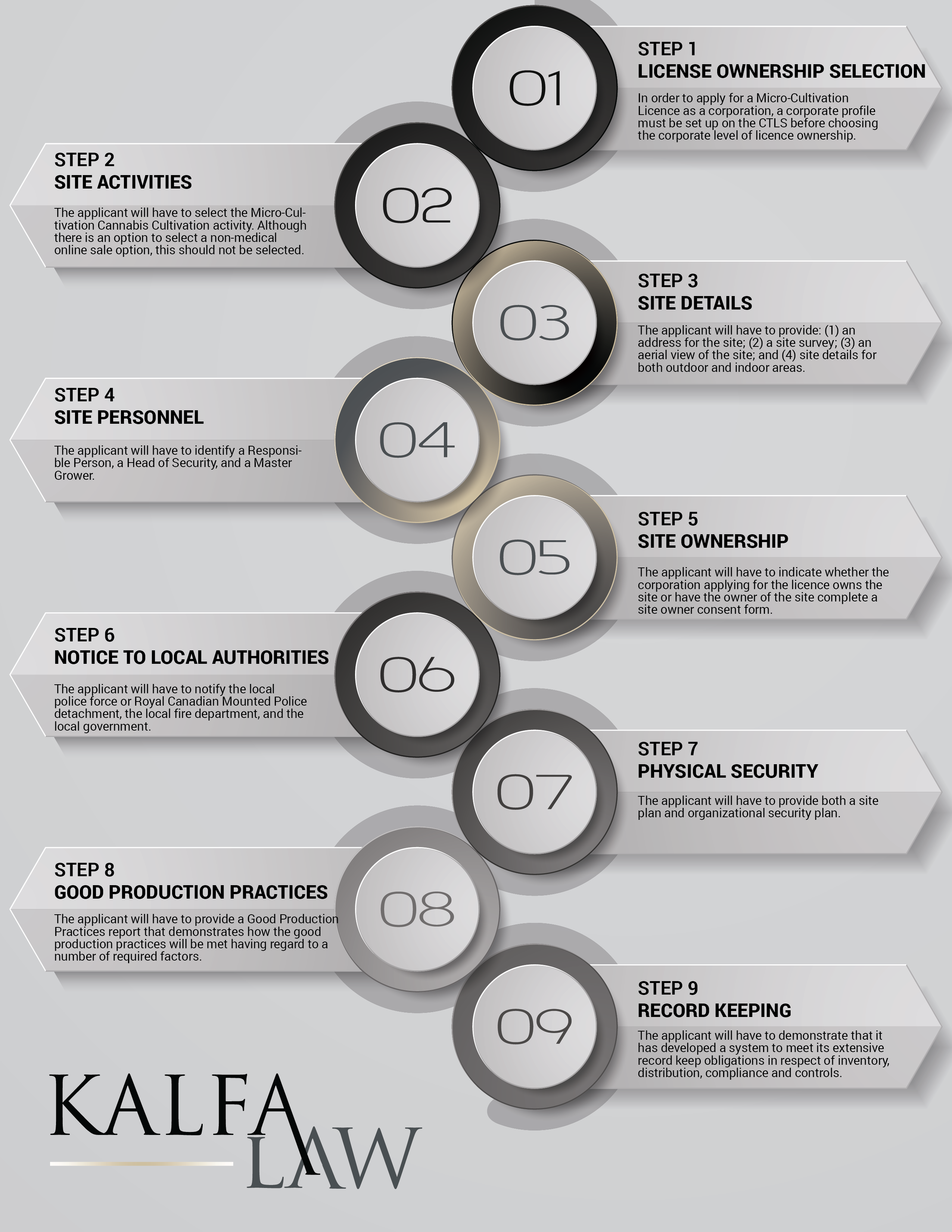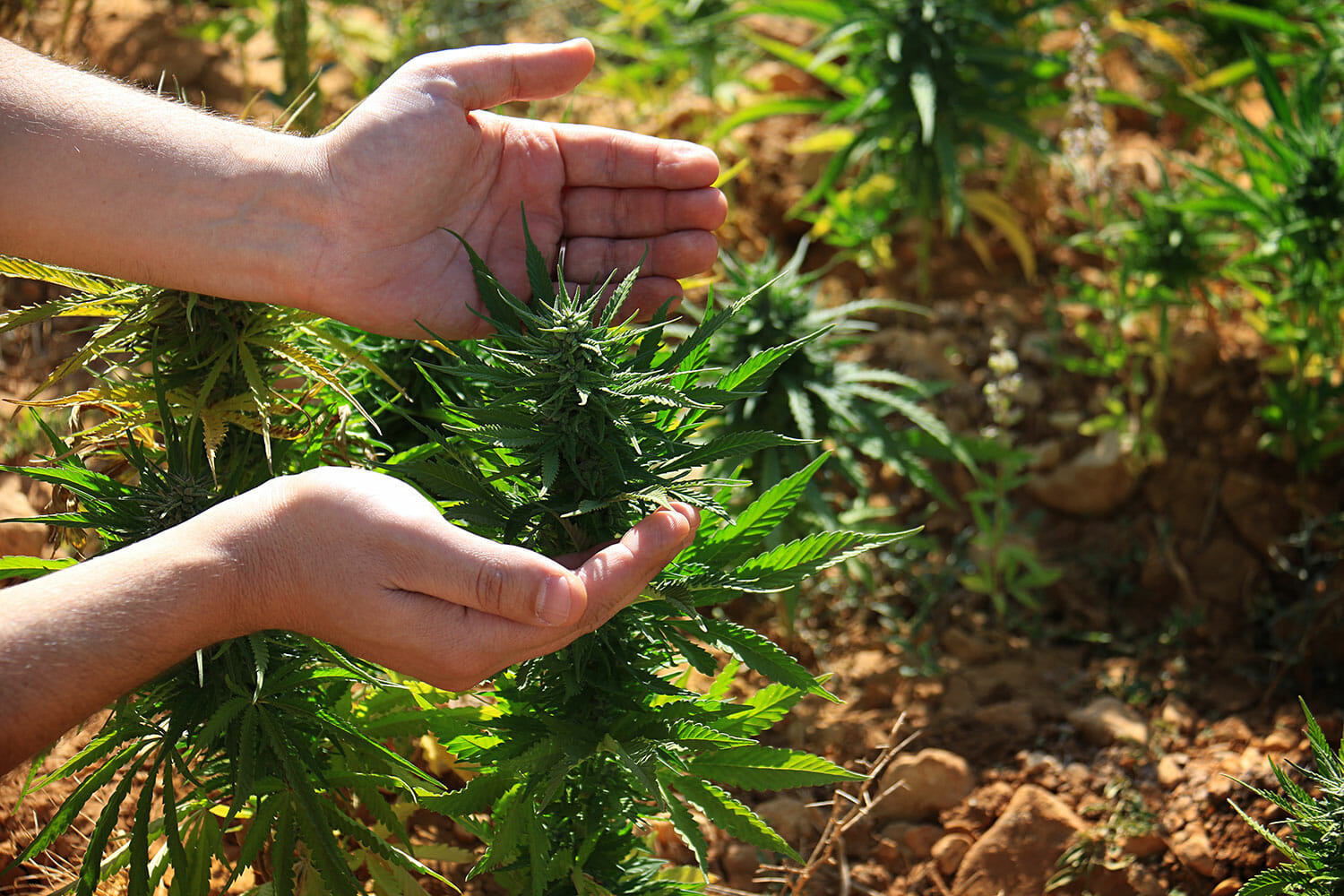The 2019 Ultimate Guide to Obtaining a Micro-Cultivation License
Here’s Everything You Need to Know about Micro-Cultivation Licensing in Ontario
The Minister of Health is now accepting applications for the cultivation of recreational cannabis. Depending on the canopy space of the proposed production facility, applicants will have to either apply for a Standard or Micro-Cultivation Licence. Canopy space refers to the surface area in which all the cannabis plants, including all the parts of the plants, must be contained.[1] The calculation of canopy space includes the total surface area being used to cultivate, propagate, or harvest cannabis plants, regardless of the configuration of the surface areas (e.g., surfaces arranged above each other).[2]
If the applicant intends to have a facility with less than 200 square meters of canopy space, the Micro-Cultivation Licence should be considered. If the applicant intendeds to have a canopy space that is greater than 200 square meters, the Standard Cultivation Licence will be required. Unlike a Micro-Cultivation Licence, having a Standard Cultivation Licence will have increased physical security requirements (e.g., visual monitoring with records being kept for one year, recording the identities of every person entering or exiting the area where cannabis stores, and an alarm or other intrusion detection system for both the perimeter of the site and indoor areas where cannabis is present, excluding growing areas).
A holder of a Micro-Cultivation Licence will be authorized to conduct the following activities: (1) possess cannabis; (2) obtain dried cannabis, fresh cannabis, cannabis plants or cannabis plant seeds by cultivating, propagating, and harvesting cannabis; (3) for the purpose of testing, to obtain cannabis by altering its chemical or physical properties by any means; and (4) to sell cannabis.[3] Further, a holder of a Micro-Cultivation Licence will be able to conduct ancillary activities (e.g., drying, trimming, and milling cannabis).[4]
A holder of a Micro-Cultivation Licence will be able to sell and distribute dried cannabis, fresh cannabis, cannabis plants, and cannabis plant seeds to the following licence holders: (1) for micro or standard cultivation; (2) for processing; (3) for analytical testing; (4) for research; and (5) a cannabis drug licence.[5]
Further, a holder of a Micro-Cultivation Licence will be able to sell directly to the Minister.[6] A holder of a Micro-Cultivation Licence will also be able to sell and distribute cannabis plants and cannabis plant seeds to the following licence holders: (1) for nursery; (2) for sale; and (3) the purchaser of the products at the request of a person authorized to sell cannabis or a holder of a licence for sale.[7]
This article will highlight the steps required to apply for a Micro-Cultivation Licence. Further, attention will be given to the relevant sections of the Cannabis Act and its Regulations to assist applicants in strengthening their application for a Micro-Cultivation Licence.
Application Process

Health Canada has established the Cannabis Tracking and Licensing System (“CTLS”) as the platform to submit applications for cannabis licences. Health Canada has also released a Cannabis Licensing Application Guide that provides an excellent summary of the requirements and process to become a licence holder under the Cannabis Act and its Regulations.[8] The first step is to create an individual user account on the CTLS. An individual user can then take steps to create a corporate profile. Prior to applying on behalf of a corporation, the directors and officers of the corporation must be included as part of the corporate profile and are required to obtain a security clearance through the CTLS. Below is a checklist that applicants can use as a guide when preparing their application:
- Licence Ownership
- Mailing Address
- Site Activities
- Site Details
- Site Personnel
- Site Ownership
- Notices to Local Authorities
- Physical Security
- Good Production Practices
- Record Keeping
1. Licence Ownership – in order to apply for a Micro-Cultivation Licence as a corporation, a corporate profile must be set up on the CTLS before choosing the corporate level of licence ownership. As a note, the corporate entity must have its head office in Canada or operate a branch office in Canada and ensure that all the officers and directors are adults.[9] It is advised that applicants choose a corporate level of licence ownership and proceed with operating the cultivation business through the corporation as there are several advantages to running a business through a corporation.
Firstly, since January 1, 2018, the combined Ontario-Federal rate of tax for small businesses is 13.5%, while the average marginal combined tax rate for income earned through a sole proprietorship is 38%. The difference results in approximately 24.5% in tax by earning business income through the corporation. Secondly, there is an opportunity for income splitting between family members involved in the corporation and the opportunity to take advantage of the Lifetime Capital Gains Exemption on the sale of shares. Thirdly, there is reduced liability by operating the business through a corporation. Lastly, there is greater flexibility with respect to planning for the future of the business as ownership is easily transferable and there is the opportunity to bring on several partners, shareholders, and investors. In order to maximize these advantages, it is advised that applicants seek the services of a lawyer and an accountant to assist with the incorporation process.
2. Mailing Address – the applicant will have to provide a mailing address. Note that this address does not need to be the site address or corporate address.
3. Site Activities – the applicant will have to select the Micro-Cultivation Cannabis Cultivation activity. Although there is an option to select a non-medical online sale option, this should not be selected.
4. Site Details – the applicant will have to provide: (1) an address for the site; (2) a site survey; (3) an aerial view of the site; and (4) site details for both outdoor and indoor areas. The site survey must be up to date at the point of submission and include a description of the legal zoning of the proposed site and all adjacent lots. The aerial view must be up to date at the point of submission and be a clear view of the site and surrounding lots to within 500 meters. All outdoor and indoor areas must be named with the activities of each space being listed (e.g., cultivation, harvesting, or drying). Note that the site details should also be included in the site plan and must meet the physical security requirements as outlined in Section 8.
5. Site Personnel – the applicant will have to identify a Responsible Person, a Head of Security, and a Master Grower. The Responsible Person will have the authority to bind the holder of the Micro-Cultivation Licence and will have overall responsibility for the activities conducted by the holder of the Micro-Cultivation Licence. The Head of Security will be responsible for ensuring that the physical security measures meet the Cannabis Regulation requirements. The Master Grower will be responsible for the cultivation, propagation, and harvesting of cannabis, and must have proficient knowledge of the Cannabis Act and its Regulations.[10] All designated site personnel will be required to obtain a security clearance through the CTLS. Note that an individual may hold multiple roles for a licence.
6. Site Ownership – the applicant will have to indicate whether the corporation applying for the licence owns the site or have the owner of the site complete a site owner consent form. The site owner onsent form must include: (1) the site address; (2) the class and subclass of the applicant; (3) the proposed activities to be conducted on site; and (4) a declaration signed by all owners of the site stating that they are the owners, that they are fully aware of the proposed cannabis activities, and that they consent to the proposed cannabis activities being carried out at that site.
7. Notice to Local Authorities – the applicant will have to notify the local police force or Royal Canadian Mounted Police detachment, the local fire department, and the local government. The notices must include: (1) the name of applicant; (2) the expected date on which the applicant will submit the application to Health Canada; (3) the class and subclass of the applicant; and (4) the site address the applicant is expected to conduct the proposed cannabis activities.
8. Physical Security – Part 4 of the Cannabis Regulations explains physical security requirements for the site plan and organizational security plan.[11] The applicant will have to provide both a site plan and organizational security plan.
The site plan must include: (1) details of the perimeter of the site; (2) details about whether the building is a multi-unit building or stand-alone building; (3) location of any outdoor cultivation; (4) details of all applicable security features; (5) floor plans of the building and site details as outlined in Section 4; and (5) product flow between the rooms must be indicates.
The organization security plan must include: (1) information on the Head of Security; (2) a site organizational chart that identifies all persons who will have management responsibility for or knowledge of any product movement, operational procedures, data entry for tracking purposes, sensitive security knowledge, and financial controls; (3) list of key individuals as identified in Section 5 and other individuals that the applicant believes should hold a valid security clearance due to the nature of their work; (4) information on how the physical security requirements will be met; (5) list of names, titles, and contact information for all individuals responsible for tracking and record keeping; (6) description of security awareness and training; (7) information on setting operational procedures; (8) other security elements that will strengthen the application (e.g., information technology protection); and (9) an attestation signed by the proposed Head of Security approving the organizational security plan.
10. Good Production Practices – Part 5 of the Cannabis Regulations explains production practices that are deemed good.[12] The applicant will have to provide a Good Production Practices Report that demonstrates how the good production practices will be met with respect to: (1) setting operational procedures; (2) pest control; (3) storage; (4) distribution; (5) building maintenance; (6) filtration of air; (7) equipment; (8) sanitation; and (9) testing.
11. Record Keeping – Part 11 of the Cannabis Regulations explains document and information retention requirements. The applicant will have to demonstrate the following record keeping requirements: (1) tracking of cannabis; (2) communications to local authorities; (3) inventory and distribution records for all cannabis produced; (4) information regarding destruction methods; (5) physical and personnel security records; (6) information on good production compliance; (7) copies of complaints and resulting investigations; (8) information on system and controls; and (9) information respecting promotional activities.
Submission

After the above information has been inputted to CTLS, the applicant will have to take the following steps. Firstly, the applicant will have the opportunity to self-identify as Indigenous affiliated. Secondly, the proposed Responsible Person must electronically attest to the following: (1) the proposed personnel are familiar with the Cannabis Act and its Regulations; (2) the proposed activities will not take place at a dwelling house; (3) the information provided is correct and complete; and (4) the person submitting the application has the authority to bind the applicant.
Once submitted, the applicant will receive a unique Licence Application ID, which will be used to effectively correspond with Health Canada and tack the status of the application. Note that pursuant to subsection 62(5) of the Cannabis Act, the Minister may later request the applicant to submit additional information. At this time, the applicant will have to take steps to fully construct the proposed facility.
Once Health Canada completes a detailed review of the application, the applicant will receive a confirmation of readiness email, which will prompt the applicant for information to demonstrate that there is a fully built out facility at the site address. The applicant will have to provide a site evidence package that includes: (1) detailed video walk through; (2) photos of the facility; and (3) site and building plans that clearly detail the completion of facility. Once Health Canada review the site evidence package, an on-site pre-licence inspection may be required.
Issuance of Micro-Cultivation Licence
After all information has been reviewed and all security clearances have been granted, an initial licence for authorization is issued. Conditions may be placed on the licence, at first, for the purpose of verifying that the cannabis products meet the standards set out under the Cannabis Regulations.
Health Canada may refuse to issue a licence under the following circumstances: (1) risk to public health and safety; (2) misleading information provided; (3) applicant has contravened the Cannabis Act, the Controlled Drugs and Substances Act, and related regulations; (4) the applicant is a young person, not ordinarily resident in Canada, or organized outside of Canada; (5) security clearance refused; and (6) public interest. In these cases, Health Canada may send an intent to refuse notice, which will provide the applicant with 30 days to respond.
Cannabis Lawyer
If you are interested in proceeding with a Micro-Cultivation License or you would like more information on the process and how we assist our clients in this field, contact us to schedule an initial no-charge consultation with one of our lawyers.
-Julian Franch, Associate Lawyer, BA, MBA, JD
© Kalfa Law Firm 2019
The above provides information of a general nature only. This does not constitute legal advice. All transactions or circumstances vary, and specified legal advice is required to meet your particular needs. If you have a legal question you should consult with a lawyer.














